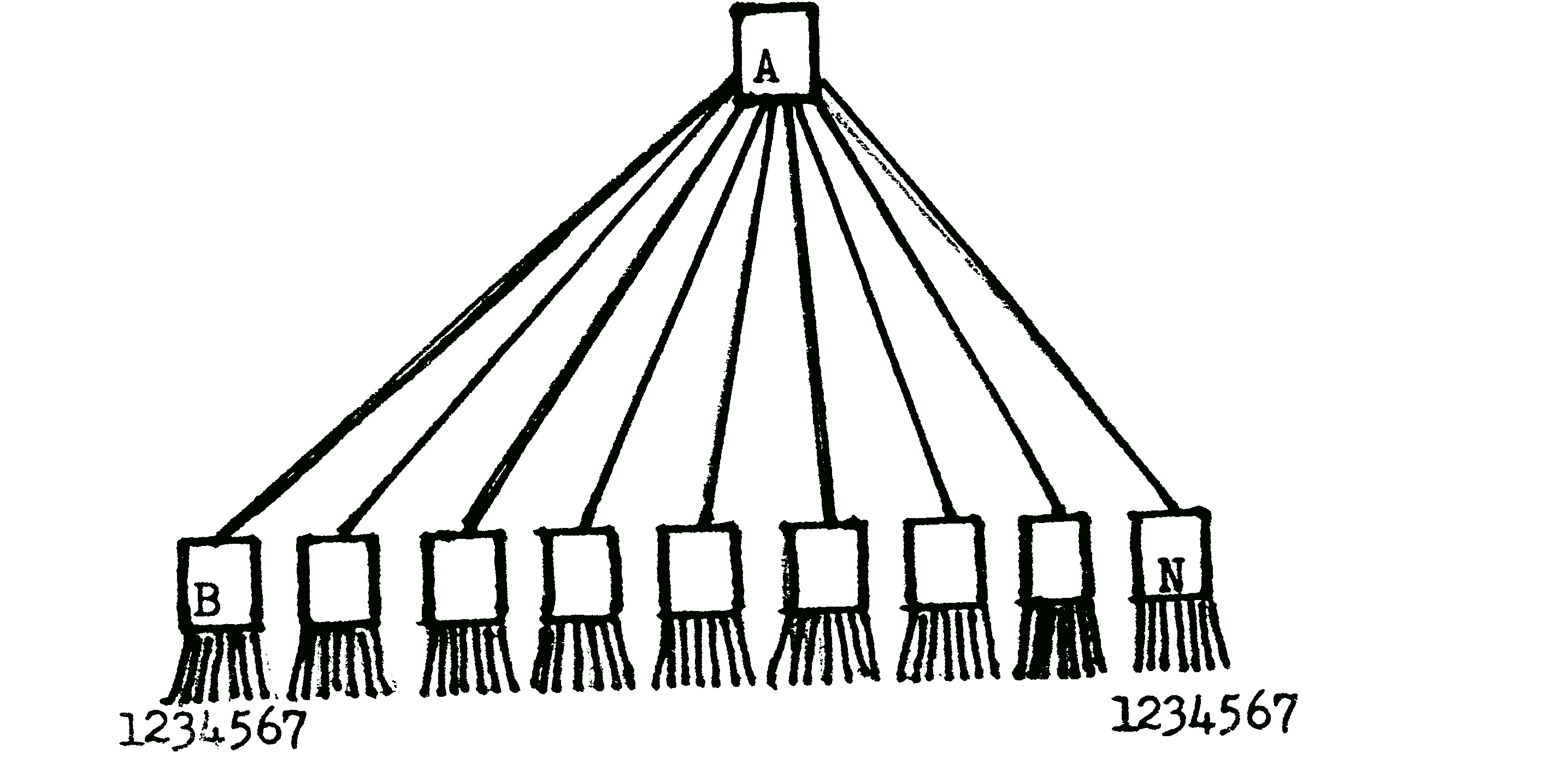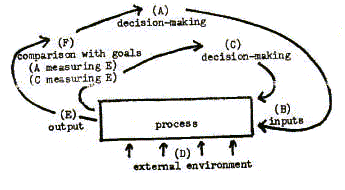

The same diagram can also represent
the organization chart of a
company,
or the distribution lines of a cable television operation. But it is
important to note the very differing ways in which these operate, or can
operate.
In terms of physical appearance, the diagram as telephone exchange system
strikes us as centralized. A call from subscriber B1 must go through B if
it is to reach B7, and through A if it is to reach N7. But A (tandem
office) and B (local central office) are merely switching centres. They
do not
veto or amend calls. With sufficient multiplicity of channels between
exchanges all calls are connected between any two subscribers and
conference calls can be arranged between more than two (all within
limitations of statistical usage; and for conference calls, the problem of
orderly communication between a larger number of participants). In terms
of social effect, our telephone (like the postal service) can facilitate
lateral or "decentralized"
communication. In another sense, however, the telephone can be used as a tool of centralization within an organization; as when a foreman might complain that in the old days the boss would be seen rarely, and workers would get on with their work largely without him, whereas today he may call for frequent intervention and perhaps even watch the process through closed-circuit TV.
Regarded as an organization chart, our diagram smacks of hierarchy. Information internal to the organization is
reported upwards from the ranks to section heads (B) and, vetoed or amended, from section head to manager (A). Instructions move down to the ranks, some originating with the manager, others from the section heads
within parameters decided by the manager. The extreme of hierarchy and
centralization is found when B1 may not communicate with B7, except
through B; or B with N except through A. In reality, such an extreme of
hierarchy and centralization is too rigid and blocked to function
effectively, save in such artificial environments as a Trappist
monastery. In reality, there is considerable lateral communication,
official or unofficial, which can either assist or subvert organizational
goals (22). The project task force,
temporarily assembled across
normal organizational divisions, is a lateralizing, decentralizing, forum
of communication. To some extent, it counters hierarchy. It is a mistake
to say it abolishes centralization and hierarchy, however. Within an
organization it is subject to the restraints of management. Between
differing organizations, each participant is subject to the restraints of
his normal employer (22b). Electronic
technology can facilitate centralization
or decentralization (23), hierarchy or
participatory democracy,
over greater distances and between a larger number of participants than was possible in the pre-electronic age.
As a diagram of a cable TV system, operating in the early Seventies, A represents the community cable carrying a limited number of program offerings; B represents the individual television dial; and by turning that dial we
make a choice between (in this case, seven) programs. The viewer in such a system is relatively passive. He can decide to receive, or reject. He cannot use such a system to project himself to another subscriber. He cannot dial programs outside what is carried on his cable. Unlike the telephone, or the Bell picturephone, the early cable TV system is not switched (except at the cable-head, where the system operator is able to decide which offerings
will be put on the cable). The cable system, in its early stages, is
uni-directional. Information flows in one direction. To this extent, it is
centralizing and hierarchic, as compared with systems permitting lateral
communication and the opportunity to dial-up offerings from other points
of
origination. When cable systems permit a subscriber to put his videotape
recorder on-line as an originating contributor, and permit other subscribers to dial-up such a contribution, or a specific program in another country, we will then say that cable is
multidirectional, multi-channel, and lateralizing. But note the relativity of this terminology: international communications of this sort would have a decentralizing impact on the nation-state, but in another sense a
potentially homogenizing impact on mankind as a whole (24). Whether a
phenomena is considered centralizing or decentralizing depends upon the position of the observer. Whether he likes it or dislikes it depends upon his value system.
In the Seventies, we see the introduction of both videophone and a significant increase in the number of channels
carried by cable. With a continued expansion of channels, and switching, the subscriber could have access to
centralized network contributions, special or minority audience
transmissions, the ability to dial distant systems, and to make limited
inputs. Inputs could be directed towards special or minority audiences,
offered to larger audiences on a random-acceptance basis (like dialing a radio hot-line program), offered to edited systems (like a letter in the correspondence columns of a newspaper), or accepted through a priority system. The instant electronic referendum or opinion poll is possible, even if of questionable desirability in the case of the former.
The telephone system can carry uni-directional messages, available to a
fairly large number of simultaneous recipients -- as when a specific
number gives callers the same message, namely, the time of day. The telephone is particularly important to us, however, as a means of lateral communication. The features of the various systems -- telephone, picturephone, cablevision, etc. -- could to some considerable extent be combined; so that we move towards a multi-channel, multi-mode, multi-directional system, linking men and computers in a sphere of communication. The Telesphere, then, is the electronic equivalent of Teilhard's Noosphere (about which we will have more to say in the final chapter).
In the Telesphere, dialing becomes a question of subscriber code, bandwidth code, central office code, area code, language code, country and continent code; of statistical loading, transmission priorities, reception priorities, and complex indicators. These very words imply criteria and decision-making, behind which must lie human values. In a very real sense, it is futile to posit abstract goals of decentralization, the end of bureaucracy, or liberation from organizational structure. In the dialectic of a complex society, some kinds of centralization are essential, some kinds of organizational structure are indispensible, and standards must be established. With electronic technology, however, centralization need no longer be so rigidly expressed in terms of a physical place, nor decision-making the prerogative of those places.
The dialectic answer to the debates of centralization/decentralization
(23), hierarchy/participation,
structure/fluidity is that we will have
all of these phenomena in the future system, just as they are characteristic of the capabilities of our emerging electronic technology. As noted in our previous mention of computerized systems, the system design may incorporate features which are humanely paternalistic, yet at the same time procrustean and reflective of the norms of a managerial priesthood. Participation in the basic decision-making process is essential if the liberating capabilities of electronic technology are to match its bureaucratizing potential.
The systems approach: a note on "noise"
We have used the term "system" so far primarily in the context of communications and computer systems. A
system is a collection of component parts existing in some relationship to each other, and within an environment.
It is often difficult to define the boundaries of a system, and the term is relative. A computer is a system,
consisting of such components as its console, control unit, memory unit, etc. As a tool of organizational accounting, however, that system is part of a broader system, which includes the clerical receipt of invoices and dispatch of others. The accounting system is, in turn, part of yet another system, and so on. Despite the problem of differentiating between system and environment, the systems approach is a valuable tool of analysis enabling us to look carefully at the relationship between structure and function of machines and organisms.
A cybernetic system is a self-steering system. At the risk of over-simplification, we can say the essential
difference between a cybernetic machine, and a living organism, as
cybernetic system, is that the machine operates within relatively fixed
parameters, whereas the living organism is more open-ended as to its goals
-- particularly in the case of organisms, such as man, with a high degree
of consciousness. A cybernetic system receives information, reacts,
measures its reaction, and continues towards its goal. The thermostat
measures a drop in temperature, turns up the heat, measures the result as
surpassing a certain level, and turns off the heat; it aims at a steady
state. The goals of individuals and societies are more complex. A nation
may aspire to the satisfactory management of its traditional territory, or
it may covet the territory or economic profits of its neighbours, etc (25).
Two ships approaching each other, warned by their radar, take corrective action. But unless they follow the rules
of navigation, one turning to one side and the other another side, they will crash or find themselves about
face. Ships return to course, but in the life of men and societies there
is rarely a return to the same course. Human societies are also
particularly prone to error in the feedback circuit -- making a mistake,
they "try harder", and aggrevate matters -- and to gaps in the
rules of navigation. The arms race is an example of feedback amplification
(26).
When buffeted by strong contradictory messages (amplifying and negative
feedback) alternating at a rapid rate, a system will suffer "nervous
breakdown." (27) Filters are needed,
enabling the system to sort
out the various messages, consolidate them in digestible packages, measure them, and make balanced decisions. Filters are necessary to exclude noise, that is, useless or detracting "blah." Noise is a problem in both electronic
transmission systems (radio transmissions, for example) and in human
communications, the communications of a society. A problem of the first
magnitude in human society is to decide what is noise or
distraction. Opinions will differ. Consider a simplified (25) diagram of a federal system:

| Home Page | Table of Contents | Next Page | Previous Page |